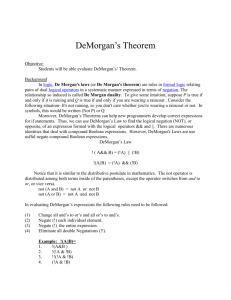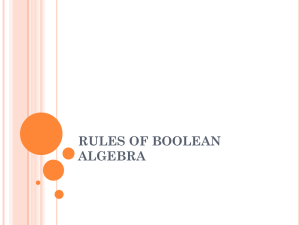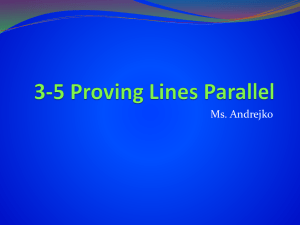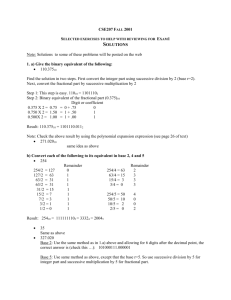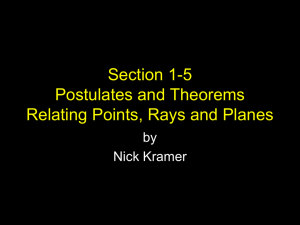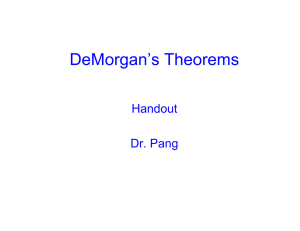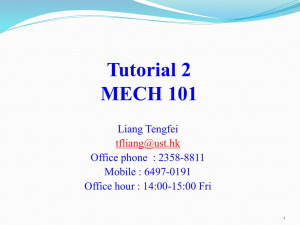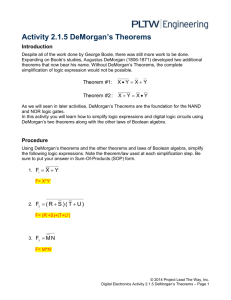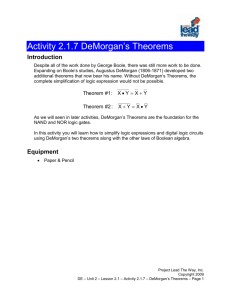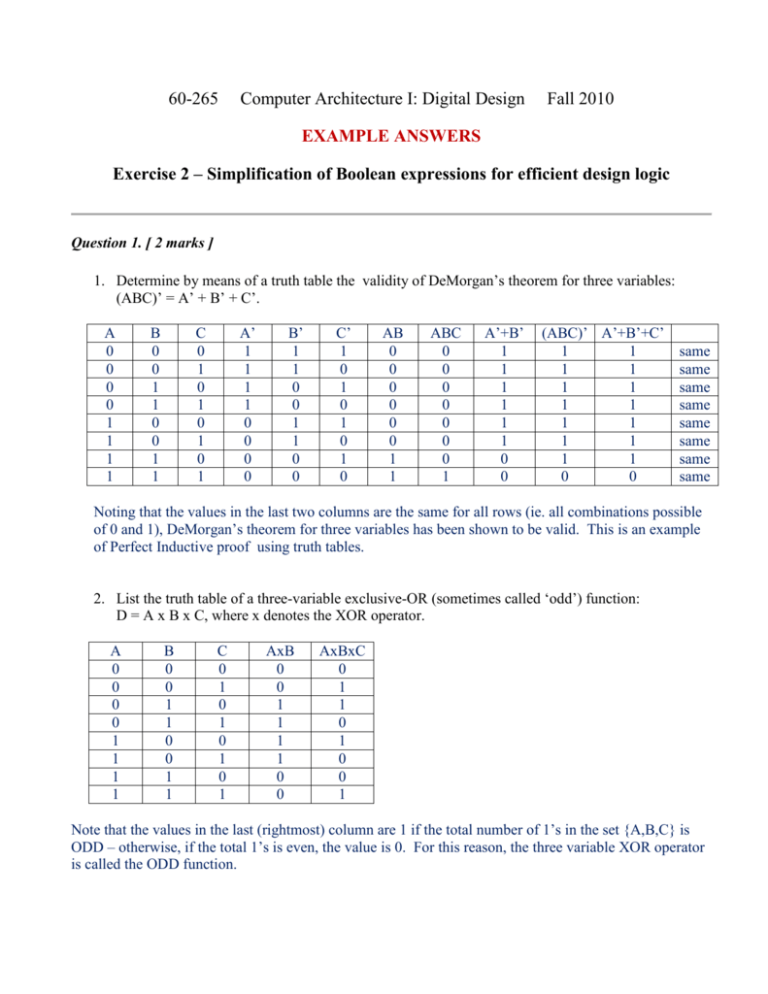
60-265
Computer Architecture I: Digital Design
Fall 2010
EXAMPLE ANSWERS
Exercise 2 – Simplification of Boolean expressions for efficient design logic
Question 1. [ 2 marks ]
1. Determine by means of a truth table the validity of DeMorgan’s theorem for three variables:
(ABC)’ = A’ + B’ + C’.
A
0
0
0
0
1
1
1
1
B
0
0
1
1
0
0
1
1
A’
1
1
1
1
0
0
0
0
C
0
1
0
1
0
1
0
1
B’
1
1
0
0
1
1
0
0
C’
1
0
1
0
1
0
1
0
AB
0
0
0
0
0
0
1
1
ABC
0
0
0
0
0
0
0
1
A’+B’
1
1
1
1
1
1
0
0
(ABC)’ A’+B’+C’
1
1
same
1
1
same
1
1
same
1
1
same
1
1
same
1
1
same
1
1
same
0
0
same
Noting that the values in the last two columns are the same for all rows (ie. all combinations possible
of 0 and 1), DeMorgan’s theorem for three variables has been shown to be valid. This is an example
of Perfect Inductive proof using truth tables.
2. List the truth table of a three-variable exclusive-OR (sometimes called ‘odd’) function:
D = A x B x C, where x denotes the XOR operator.
A
0
0
0
0
1
1
1
1
B
0
0
1
1
0
0
1
1
C
0
1
0
1
0
1
0
1
AxB
0
0
1
1
1
1
0
0
AxBxC
0
1
1
0
1
0
0
1
Note that the values in the last (rightmost) column are 1 if the total number of 1’s in the set {A,B,C} is
ODD – otherwise, if the total 1’s is even, the value is 0. For this reason, the three variable XOR operator
is called the ODD function.
Question 2. [ 5 marks ]
Simplify the following expressions using Boolean algebra. In each case, state the Axiom (ie. Postulate)
or Theorem being applied at each step.
For the answers below, we refer to the following Postulates and Theorems (see lecture notes):
P1: Closure: There exists x,y in B such that two independent operations, . (dot) and + (plus) are defined:
x+y
x.y
P2: Identity: There exist identity elements 0,1 in B relative to the operations + and . , such that for every
x in B:
0+x = x+0 = x
1.x = x.1 = x
P3: Commutativity: The operations + and . are commutative for all x,y in B:
x + y = y + x
x.y = y.x
P4: Distributivity: Each operation + and . is distributive over the other; that is, for all x,y,z in B:
x.(y+z) = x.y + x.z
x+(y.z) = (x+y).(x+z)
P5: Complementation: For every element x in B there exists an element ~x, called the complement of x,
satisfying:
x + ~x = 1
x.~x = 0
P6: Existence: There exist at least two elements x,y in B such that x ≠ y.
T2: For each X in B: X + 1 = 1
X.0=0
a. A + AB
Derivative step
A.1 + A.B
A(1+B)
A.1
A
Postulate
P2
P4
T2
P2
Final answer: A
b. AB + AB’
Derivative step
A(B+B’)
A.1
A
Postulate
P4
P5
P2
Final answer: A
c. A’BC + AC
Derivative step
(A’B+A)C
(A’+A)(B+A)C
1.(B+A)C
(B+A)C
Postulate
P4
P4
P5
P2
Final answer: (B+A)C = (A+B)C = C(A+B) etc (all similar forms are equivalent).
d. A’B + ABC’ + ABC
Derivative step
A’B + ABC’ + ABC’ + ABC
B(A’ + AC’) + AB(C’ + C)
B(A’ + AC’) + AB.1
B(A’ + AC’) + AB
B(A’ + AC’ + A)
B(A’ + A + AC’)
B(1 + AC’)
B.1
B
Post/Thm
Idempotent
P3, P4
P5
P2
P4
P3
P5
T2
P2
Final answer: B
e. AB + A(CD + CD’)
Derivative step
AB + AC(D + D’)
AB + AC.1
AB + AC
A(B + C)
Postulate
P4
P5
P2
P4
Final answer: A(B + C) NOTE: This answer is simpler than the second last line above due
to the fact that the number of operations is only 2 (one OR, one AND) in the last line, versus 3
(one OR, two AND) in the second last line.
f. (BC’ + A’D)(AB’ + CD’)
Derivative step
BC’(AB’ + CD’) + A’D(AB’ + CD’)
BC’AB’ + BC’CD’ + A’DAB’ + A’D CD’
ABB’C’ + BCC’D’ + AA’B’D + A’CDD’
A.0.C’ + B.0.D’ + 0.B’D + A’C.0
0+0+0+0
0
Postulate
P4
P4
P3
P5
T2
P2
Final answer: 0 NOTE: It is interesting (to say the least) that a complicated circuit design
involving many inputs may simplify to a very simple circuit, as in this case where the output is
0 regardless of the inputs.
Question 3. [ 3 marks ]
1. Using DeMorgan’s theorem, show that:
a. (A + B)’(A’ + B’)’ = 0
(A + B)’(A’ + B’)’ = ((A + B) + (A’ + B’))’
= ((A + A’) + (B + B’))’ = ( 1 + 1 )’
= 1’
= 0 QED!
b. A + A’B + A’B’ = 1
A + A’B + A’B’ = A + A’(B + B’)
= A + A’(B’B)’
= A + A’(0)’
= A + A’.1
= A + A’
= (A’A)’
= (0)’
= 1 QED!
NOTE: This example is notably inefficient in how a higher order theorem, such as
deMorgan’s theorem, is used to get the result. The same result could obviously have been
achieved in fewer steps by applying the postulates directly, or simpler theorems.
2. Given the Boolean expression: F = X’Y + XYZ’
Before beginning, note that F = (X’ + XZ’)Y = (X’+Z’)Y (see examples above).
a. Derive an algebraic expression for the complement F’.
F’ = (X’Y + XYZ’)’ = (X’Y)’.(XYZ’)’
= (X’’ + Y’)(X’ + Y’ + Z’’)
= (X + Y’)(X’ + Y’ + Z)
Which simplifies to:
= (X+Y’)X’ + (X+Y’)Y’ + (X+Y’)Z
= X’Y’ + XY’ + Y’ + XZ + Y’Z
= Y’ + XZ + Y’Z
= Y’ + XZ
It is possible to show this more directly, using:
F’ = ((X’+Z’)Y)’ = (X’+Z’)’ + Y’ [deMorgan] = XZ + Y’ [deMorgan]
b. Show that FF’ = 0. (Use algebra, not truth tables)
If we start with the simplified form of F = (X’+Z’)Y, then:
FF’
= ((X’+Z’)Y).(Y’ + XZ)
= (XZ)’(YY’ + YXZ)
= (XZ)’Y(XZ)
= 0 QED!
[deMorgan, Distributive]
[Complement, Identity]
[Complement]
c. Show that F + F’ = 1. (Use algebra, not truth tables)
If we start with the simplified form of F = (X’+Z’)Y, then:
F+F’ = (X’+Z’)Y + (Y’ + XZ)
= (XZ)’Y + (Y’ + XZ)
= Y’ + XZ + (XZ)’Y
= Y’+ (XZ)’Y + ((XZ) + (XZ)’)(XZ + Y)
= Y’+ (XZ)’ + (XZ + Y)
= (Y+Y’) + ((XZ) + (XZ)’)
=1+1
= 1 QED!
© All information on this website is Copyright © 2010 by Robert D. Kent. All rights reserved.


